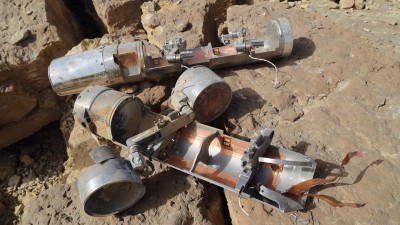NOVANEWS

Featured image: Two BLU-108 canisters, one with with two skeet (submunitions) still attached, found in the al-Amar area of al-Safraa in northern Yemen’s Saada governorate after an attack on April 27, 2015.
A Saudi Arabia-led coalition is using recently transferred US-manufactured cluster munitions in civilian areas of Yemen contrary to US export requirements.
Field research by Human Rights Watch, Amnesty International, and the United Nations; interviews with witnesses and victims; and photographs and video evidence confirm that a Saudi Arabia-led coalition is using banned cluster munitions in Yemen. The coalition of nations has been conducting a military operation in Yemen against Houthi forces, also known as Ansar Allah, since March 26, 2015.
Human Rights Watch believes the Saudi Arabia-led coalition is responsible for all or nearly all of these cluster munition attacks in this period because it is the only entity operating aircraft or multibarrel rocket launchers capable of delivering five of the six types of cluster munitions that have been used in the conflict.
One type of air-dropped cluster munition used by the Saudi-led coalition in Yemen is the CBU-105 Sensor Fuzed Weapon, manufactured by Textron Systems Corporation of Wilmington, Massachuetts. Human Rights Watch has investigated at least five attacks involving the use of CBU-105 Sensor Fuzed Weapons in four governorates since March 2015.
Most recently, CBU-105 Sensor Fuzed Weapons were used in a December 12, 2015 attack on the Yemeni port town of Hodaida, injuring a woman and two children in their homes. At least two civilians were wounded when CBU-105 Sensor Fuzed Weapons were used near al-Amar village in Saada governorate on April 27, 2015, according to local residents and medical staff.
“Sensor Fuzed Weapons are touted by some as the most high tech, reliable cluster munitions in the world, but we have evidence that they are not working the way they are supposed to in Yemen, and have harmed civilians in at least two attacks,” said CMC chair Steve Goose, Human Rights Watch arms division director. “The evidence raises serious questions about compliance with US cluster munition policy and export rules.”
While any use of any type of cluster munition should be condemned, there are two additional disturbing aspects to the use of CBU-105 Sensor Fuzed Weapons in Yemen. First, US export law prohibits recipients of cluster munitions from using them in populated areas, as the Saudi coalition has clearly been doing. Second, US export law only allows the transfer of cluster munitions with a failure rate of less than 1 percent. But it appears that Sensor Fuzed Weapons used in Yemen are not functioning in ways that meet that reliability standard.
In recent years, the US has supplied these weapons to Saudi Arabia and the United Arab Emirates (UAE), both of which possess attack aircraft of US and Western/NATO origin capable of delivering them. CBU-105 Sensor Fuzed Weapons are the only cluster munitions currently exported by the US, and the recipient must agree not to use them in civilian areas. According to the US government, CBU-105 Sensor Fuzed Weapons are the only cluster munition in its active inventory “that meet[s] our stringent requirements for unexploded ordnance rates,” with a claimed failure rate of less than 1 percent.
According to a Textron Systems Corporation datasheet, the CBU-105 disperses 10 BLU-108 canisters that each release four submunitions the manufacturer calls “skeet” that are designed to sense, classify, and engage a target such as an armored vehicle. The submunitions explode above the ground and project an explosively formed jet of metal and fragmentation downward. The skeet are equipped with electronic self-destruct and self-deactivation features.
However, photographs taken by Human Rights Watch field investigators at one location and photographs received from another location show BLU-108 from separate attacks with their “skeets” or submunitions still attached. This shows a failure to function as intended as the submunitions failed to disperse from the canister, or were dispersed but did not explode.
Yemen, the US, and Saudi Arabia and its coalition members should join the 2008 Convention on Cluster Munitions, Human Rights Watch said.
In a March 30, 2015 letter the Cluster Munition Coalition U.S. urged President Barack Obama to review the 2008 cluster munitions policy, and to remove the exception allowing cluster munitions that result in less than 1 percent unexploded ordnance rate.
Human Rights Watch believes the Saudi Arabia-led coalition is responsible for all or nearly all of these cluster munition attacks in this period because it is the only entity operating aircraft or multibarrel rocket launchers capable of delivering five of the six types of cluster munitions that have been used in the conflict.
One type of air-dropped cluster munition used by the Saudi-led coalition in Yemen is the CBU-105 Sensor Fuzed Weapon, manufactured by Textron Systems Corporation of Wilmington, Massachuetts. Human Rights Watch has investigated at least five attacks involving the use of CBU-105 Sensor Fuzed Weapons in four governorates since March 2015.
Most recently, CBU-105 Sensor Fuzed Weapons were used in a December 12, 2015 attack on the Yemeni port town of Hodaida, injuring a woman and two children in their homes. At least two civilians were wounded when CBU-105 Sensor Fuzed Weapons were used near al-Amar village in Saada governorate on April 27, 2015, according to local residents and medical staff.
“Sensor Fuzed Weapons are touted by some as the most high tech, reliable cluster munitions in the world, but we have evidence that they are not working the way they are supposed to in Yemen, and have harmed civilians in at least two attacks,” said CMC chair Steve Goose, Human Rights Watch arms division director. “The evidence raises serious questions about compliance with US cluster munition policy and export rules.”
While any use of any type of cluster munition should be condemned, there are two additional disturbing aspects to the use of CBU-105 Sensor Fuzed Weapons in Yemen. First, US export law prohibits recipients of cluster munitions from using them in populated areas, as the Saudi coalition has clearly been doing. Second, US export law only allows the transfer of cluster munitions with a failure rate of less than 1 percent. But it appears that Sensor Fuzed Weapons used in Yemen are not functioning in ways that meet that reliability standard.
In recent years, the US has supplied these weapons to Saudi Arabia and the United Arab Emirates (UAE), both of which possess attack aircraft of US and Western/NATO origin capable of delivering them. CBU-105 Sensor Fuzed Weapons are the only cluster munitions currently exported by the US, and the recipient must agree not to use them in civilian areas. According to the US government, CBU-105 Sensor Fuzed Weapons are the only cluster munition in its active inventory “that meet[s] our stringent requirements for unexploded ordnance rates,” with a claimed failure rate of less than 1 percent.
According to a Textron Systems Corporation datasheet, the CBU-105 disperses 10 BLU-108 canisters that each release four submunitions the manufacturer calls “skeet” that are designed to sense, classify, and engage a target such as an armored vehicle. The submunitions explode above the ground and project an explosively formed jet of metal and fragmentation downward. The skeet are equipped with electronic self-destruct and self-deactivation features.
However, photographs taken by Human Rights Watch field investigators at one location and photographs received from another location show BLU-108 from separate attacks with their “skeets” or submunitions still attached. This shows a failure to function as intended as the submunitions failed to disperse from the canister, or were dispersed but did not explode.
Yemen, the US, and Saudi Arabia and its coalition members should join the 2008 Convention on Cluster Munitions, Human Rights Watch said.
In a March 30, 2015 letter the Cluster Munition Coalition U.S. urged President Barack Obama to review the 2008 cluster munitions policy, and to remove the exception allowing cluster munitions that result in less than 1 percent unexploded ordnance rate.



